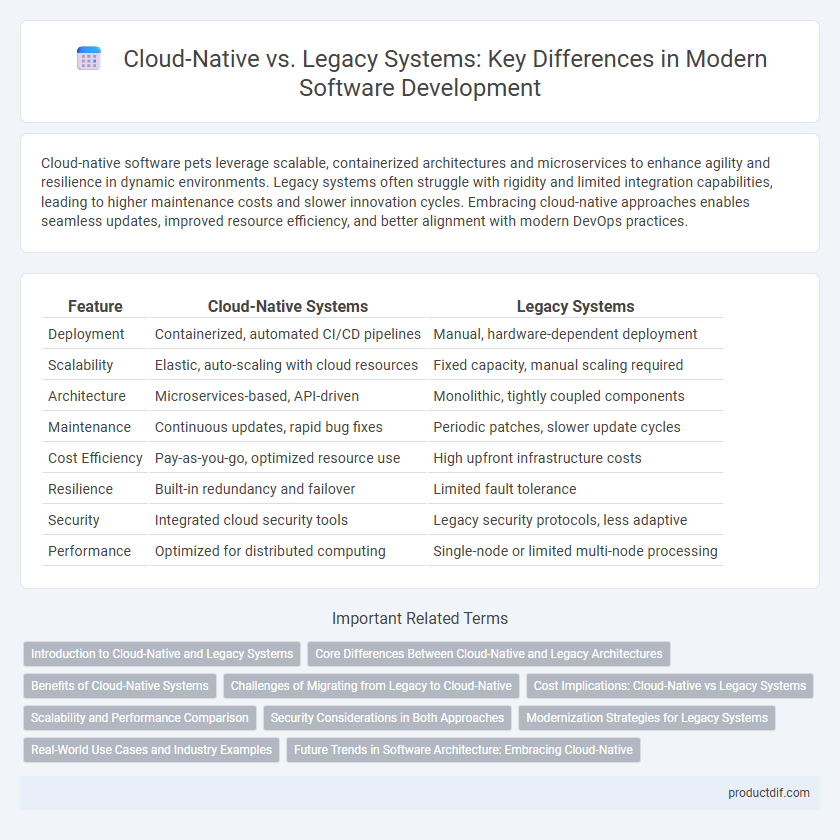Cloud-native software pets leverage scalable, containerized architectures and microservices to enhance agility and resilience in dynamic environments. Legacy systems often struggle with rigidity and limited integration capabilities, leading to higher maintenance costs and slower innovation cycles. Embracing cloud-native approaches enables seamless updates, improved resource efficiency, and better alignment with modern DevOps practices.
Table of Comparison
| Feature | Cloud-Native Systems | Legacy Systems |
|---|---|---|
| Deployment | Containerized, automated CI/CD pipelines | Manual, hardware-dependent deployment |
| Scalability | Elastic, auto-scaling with cloud resources | Fixed capacity, manual scaling required |
| Architecture | Microservices-based, API-driven | Monolithic, tightly coupled components |
| Maintenance | Continuous updates, rapid bug fixes | Periodic patches, slower update cycles |
| Cost Efficiency | Pay-as-you-go, optimized resource use | High upfront infrastructure costs |
| Resilience | Built-in redundancy and failover | Limited fault tolerance |
| Security | Integrated cloud security tools | Legacy security protocols, less adaptive |
| Performance | Optimized for distributed computing | Single-node or limited multi-node processing |
Introduction to Cloud-Native and Legacy Systems
Cloud-native systems leverage containerization, microservices, and dynamic orchestration to enable scalable, resilient, and flexible software deployment on cloud platforms. Legacy systems, often built on monolithic architecture with tightly coupled components, struggle to adapt to modern agile practices and cloud infrastructure, limiting scalability and innovation. Transitioning from legacy to cloud-native architecture enhances operational efficiency, accelerates development cycles, and improves integration with contemporary technologies.
Core Differences Between Cloud-Native and Legacy Architectures
Cloud-native architectures leverage microservices, containerization, and dynamic orchestration to enhance scalability and resilience, whereas legacy systems rely on monolithic structures with limited flexibility. Cloud-native systems prioritize infrastructure automation and continuous integration/continuous deployment (CI/CD), enabling rapid updates and efficient resource usage. Legacy architectures often suffer from rigid deployment cycles and hardware dependencies, hindering agility and innovation.
Benefits of Cloud-Native Systems
Cloud-native systems offer enhanced scalability and flexibility by leveraging containerization and microservices architecture, allowing seamless resource allocation based on demand. These systems improve deployment speed and operational efficiency through continuous integration and continuous delivery (CI/CD) pipelines, enabling rapid updates and fault isolation. Enhanced security posture is achieved by incorporating automated security testing and compliance monitoring within the cloud infrastructure, reducing vulnerabilities compared to legacy monolithic systems.
Challenges of Migrating from Legacy to Cloud-Native
Migrating from legacy systems to cloud-native architectures presents challenges such as data integration complexities, where tightly coupled monolithic applications require significant refactoring to adopt microservices. Compatibility issues arise due to outdated technologies and inconsistent APIs, increasing the risk of downtime and data loss during the transition. Ensuring security and compliance in cloud environments demands redesigning legacy security protocols to fit distributed, multi-tenant infrastructures, often requiring specialized expertise and new toolsets.
Cost Implications: Cloud-Native vs Legacy Systems
Cloud-native systems typically reduce operational costs by leveraging scalable infrastructure and automated deployment, minimizing the need for extensive on-premises hardware and manual maintenance. Legacy systems often incur higher expenses due to rigid architectures, costly hardware upgrades, and labor-intensive support requirements. Organizations adopting cloud-native solutions benefit from pay-as-you-go pricing models, which align costs more closely with actual resource usage and demand fluctuations.
Scalability and Performance Comparison
Cloud-native systems leverage microservices architecture and containerization to enable dynamic scalability and optimal resource utilization, resulting in superior performance under variable workloads. Legacy systems often face limitations with monolithic designs that hinder horizontal scaling and lead to bottlenecks during peak demand. The inherent flexibility of cloud-native platforms supports automated scaling and faster response times compared to traditional legacy infrastructures.
Security Considerations in Both Approaches
Cloud-native systems leverage microservices architecture and automated security updates to reduce vulnerabilities and enable rapid threat response, enhancing overall security posture. Legacy systems often rely on monolithic designs with limited patching capabilities, increasing the risk of exposure to known exploits and slower incident mitigation. Integrating modern security frameworks and continuous monitoring tools is essential for hybrid environments combining cloud-native and legacy components.
Modernization Strategies for Legacy Systems
Modernization strategies for legacy systems prioritize migrating to cloud-native architectures to enhance scalability, flexibility, and resilience. Common approaches include rehosting, refactoring, and rebuilding applications using containerization, microservices, and serverless computing. Implementing DevOps practices and automated CI/CD pipelines accelerates the transition and ensures continuous improvement in performance and security.
Real-World Use Cases and Industry Examples
Cloud-native applications leverage microservices, containerization, and dynamic orchestration tools like Kubernetes, enabling companies like Netflix and Spotify to achieve rapid scalability and continuous deployment. Legacy systems, often monolithic and rigid, remain prevalent in banking and government sectors where stability and regulatory compliance are prioritized over agility. Hybrid strategies combining cloud-native flexibility with legacy reliability are increasingly adopted in industries such as healthcare, maximizing operational efficiency while mitigating risks.
Future Trends in Software Architecture: Embracing Cloud-Native
Cloud-native architectures prioritize containerization, microservices, and orchestration tools like Kubernetes to enable scalability and resilience, outperforming legacy monolithic systems limited by rigid infrastructure. Future software development emphasizes adopting serverless computing and edge technologies to enhance agility while reducing operational overhead. Enterprises investing in cloud-native strategies benefit from continuous integration/continuous deployment (CI/CD) pipelines, driving faster innovation cycles and improved system reliability.
Cloud-Native vs Legacy Systems Infographic

 productdif.com
productdif.com